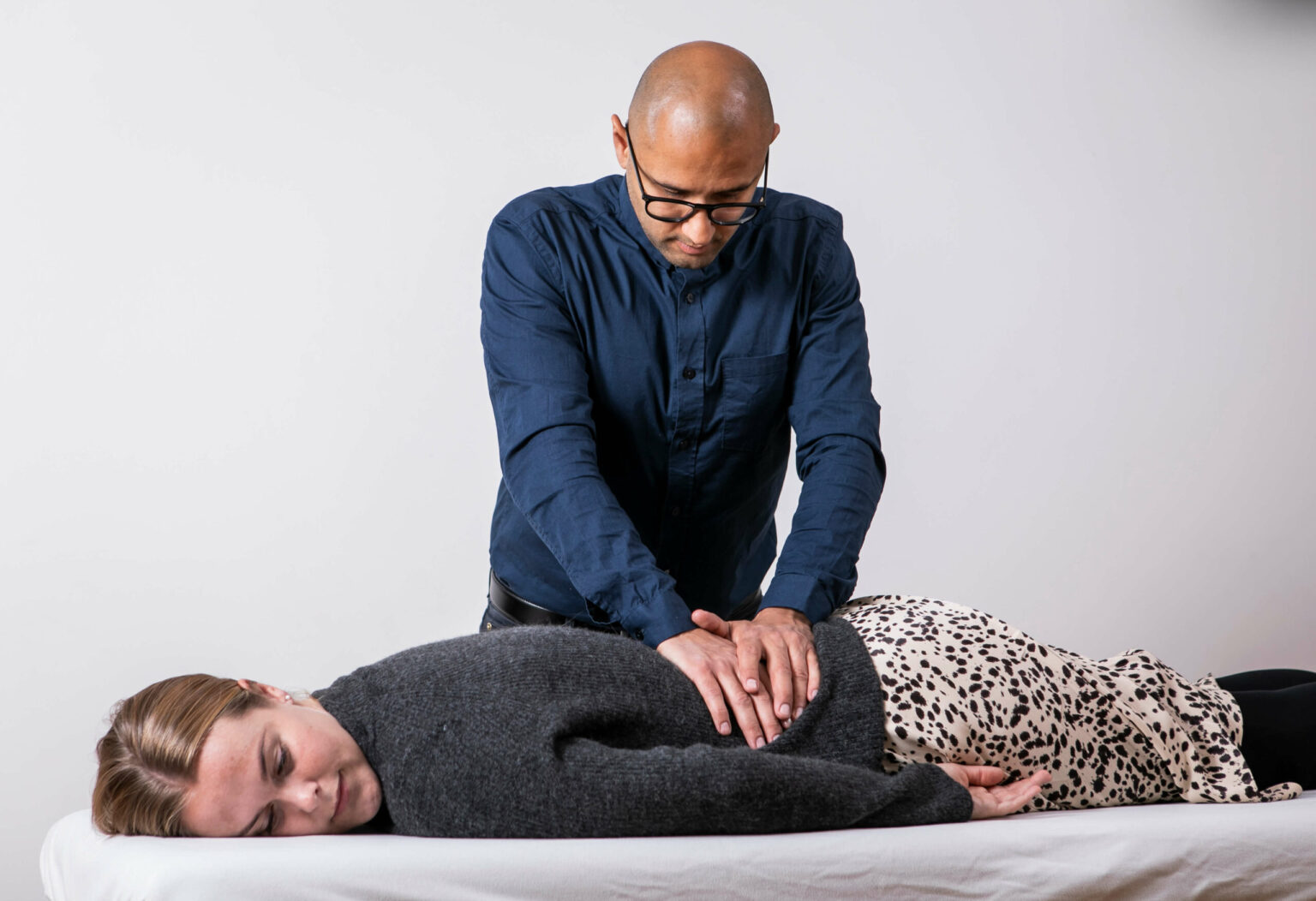We treat
Sciatica pain & piriformis syndrome
Learn more about sciatica pain on this subpage.
Sciatica pain & piriformis syndrome
Many people will experience sciatica pain at some point in their lives.
Sciatica is not an actual disease, but an overall term or symptom for pain that radiates from the back down the leg.. When it comes to actual sciatica pain, the sciatic nerve itself is affected in one or more places on its way from the lower vertebrae and sacrum, down to the buttocks, hamstrings and lower legs.
Jump to section [Vis]
Sciatica
The sciatic nerve originates from the lower lumbar vertebrae and the sacrum. It joins together to form a single nerve deep in the buttock, then runs past the piriformis muscle and then past the ischium into and between the hamstring muscles. When it reaches the knee, it branches into two nerves that run to the front of the lower leg and to the calf muscles and out to the foot. The function of the sciatic nerve is to supply (provide function to) the muscles in the buttock, hamstring, calf and foot. The nerve also supplies the skin from the back of the back, buttock, hamstring and down to the foot.
Symptoms of sciatic nerve compression will be experienced as radiating pain either throughout the entire leg down to the toes or just pain in the buttock and/or hamstring.
Sciatica can also be experienced as a sensory disturbance (reduced sensation) in an area or the entire back of the leg. In advanced and severe cases, sciatica pain can also be experienced as reduced strength in the leg where the leg is not always controllable.

Sciatica during pregnancy
Many pregnant women will experience symptoms of sciatica at some point, such as pain in the back, buttocks, and/or legs. As the baby grows in the womb, pressure increases in the abdomen (belly) and pelvis. This increase in pressure can often cause direct pressure on the nerves in the spine and/or pelvis.
The fact that the pelvis loosens in the first and last trimesters can also cause symptoms of sciatica as the nerve can become pinched in the pelvis.
The pregnant woman will also change the way she walks from walking more in a vertical plane (rotation) to walking more in a horizontal plane (side to side). This puts enormous stress on the pelvis, especially the hip and pelvic floor muscles (piriformis muscle) where the sciatic nerve runs.
Causes of sciatica pain – can originate from other places in the body
Pain originating from the sciatic nerve is many and varied. It can originate from different systems in the body.
Musculoskeletal system or mechanical sciatica pain
The pain is caused by compression due to lack of space in one or more of the places where the sciatic nerve runs through the leg. Below are all the mechanical causes of sciatica pain.
Disc herniation or disc protrusion (disc protrusion)
Pressing on the nerve where it emerges from the spine. Scar tissue after a herniated disc or herniated disc surgery can also be the cause.
Osteoarthritis can affect sciatica
Osteoarthritis and/or changes in the vertebrae where the nerve originates.
Spinal stenosis and sciatica
Spinal stenosis, i.e. narrowing of the spinal canal.
Spondylolisthesis can cause sciatica
Spondylolisthesis or forward slippage of a vertebra.
Piriformis and sciatica
Pinching in the buttock (piriformis syndrome) – read later.
Sciatica in the hamstring
Irritation of the nerve in the hamstring due to tight connective tissue, scar tissue, bleeding, etc.
Sciatica in the lower leg
Pinching of the nerve on the outside of the knee due to trauma to the knee, sprained ankle, etc.

The circulatory system and sciatica pain
Dysfunction in the venous blood system is often the cause of sciatica pain. Here, symptoms will be worst when the blood system is inactive (sitting, standing still, in the morning or evening) but better during movement where the venous pump is active.
Problems with the lungs, heart, liver, kidneys, and digestive system are the cause of these dysfunctions.
The areas below can cause veins to press on the sciatic nerve.
Blood vessels (veins) in the spine cause sciatica
In the intervertebral foramen where the branches of the sciatic nerve emerge from the spine, where veins also emerge from the vertebra.
Accumulation of blood in the pelvis and sciatica
In the pelvis and buttocks where swelling inside the pelvis itself can press on the buttock muscle (piriformis).
CranioSacral System and Sciatica
The dura mater protects and covers the brain itself in the skull. This membrane continues through the spine and covers the spinal cord. The dura mater continues 1-2 cm along the branches that form the sciatic nerve. Whiplash, head trauma and/or falls on the tailbone will often be the trigger for problems in the craniosacral system.
The nervous system and sciatica
Pathology of the nervous system, such as nerve inflammation, can also be the cause of sciatica pain. In these problems, symptoms will be constant and will not improve with different positions, activities, or different times of day.
Neuritis is inflammation of the peripheral nervous system, i.e. the system that originates from the spine.
Causes of the pathology originate in dysfunction of the body’s various systems, including the hormonal system, the blood system and or due to a lack of vitamins and minerals or diabetes, etc.
Piriformis syndrome
Every human being can be placed into three main groups:
Piriformis syndrome, like sciatica, is not a diagnosis or actual disease, but a term for the compression of the sciatic nerve where it runs past the muscle. Piriformis is a pelvic muscle that originates from the lower part of the sacrum and has its attachment on the outside of the femur. The function of the muscle is, among other things, to rotate the hip joint outwards, where it plays an important role in, among other things, walking and running.
Symptoms of piriformis syndrome are similar to sciatica pain, but the pain originates from the buttock itself and not the back.
Causes of piriformis syndrome
Causes of piriformis syndrome, like sciatica pain, can originate from various systems in the body.
Here are the most common reasons;
Sacrum/tailbone and piriformis syndrome.
Misalignment of the sacrum after a fall on the coccyx/sacrum or lower abdominal problems.
Back problems and piriformis syndrome.
Back problems such as locking or stiffness in the lower back and pelvis.
Blow to the buttock and piriformis syndrome
Trauma or blow to the buttock.
Digestion can affect piriformis syndrome
Digestive problems or problems with bowel movements.

Osteopathy and sciatica
We are experts in finding the cause or causes of these problems, examining and treating all systems in the body. This helps to provide fast and lasting results for sciatica pain and piriformis syndrome.
Sciatica and piriformis syndrome often require physiotherapy rehabilitation (physiotherapist specializing in sciatica) to strengthen and stabilize muscles and connective tissue.
Physiotherapy and sciatica
The physiotherapist will look at sciatica pain with exercise-related eyes, i.e. the physiotherapist at Osteonordic will treat sciatica with exercises, exercise therapy and manual treatment. Physiotherapists here at the clinic are specialists in rehabilitation and mobilization of the sciatic nerve.
Acupuncture and sciatica
Acupuncture can be an effective tool for sciatica pain as the acupuncture needle can penetrate deep into the buttock, down to the piriformis muscle where the sciatic nerve is often pinched or compressed. Acupuncture can also optimize blood flow in and around the sciatic nerve.
Massage and sciatica
Massage softens and loosens the muscles and joints that the sciatic nerve is related to. Massage can also treat the areas where the sciatic nerve runs through the hamstring, calf, etc.

Often related problems

Spinal stenosis

Hypermobility in babies and children

Muscle tension or imbalances in babies and children

Modic Changes

Disc herniation

Spinal arthritis

Winged scapula

